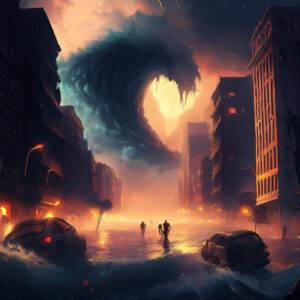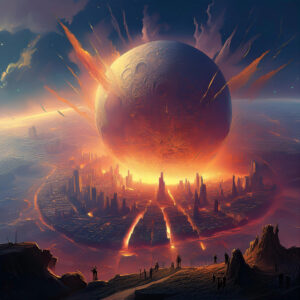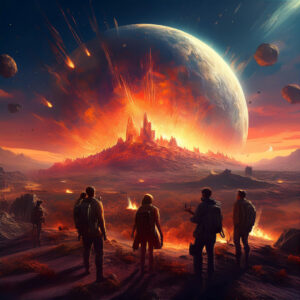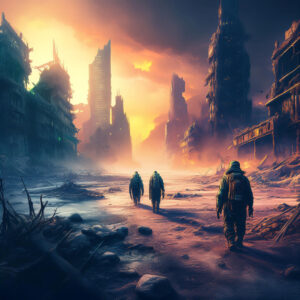- abaashishb7
- February 13, 2025
- 10:59 am
- No Comments
What If the Moon hit earth Earth?
What If the Moon hit earth Earth?
* Terrifying Reality: What If the Moon Crashed Into Earth?
The Moon orbits Earth at an average distance of 238,855 miles (384,400 kilometers). Disruption of the Moon’s orbit would have profound implications for our planet. Its gravitational influence is vital for maintaining the stability of Earth’s axial tilt, which in turn regulates our climate and seasonal patterns. Without this stabilizing effect, Earth’s tilt could become unpredictable, potentially resulting in severe seasonal fluctuations or significant climate changes over time.
Moreover, the Moon plays a critical role in generating ocean tides, which are essential for the health of marine ecosystems. A diminished or absent Moon could lead to weaker tidal movements, adversely affecting coastal habitats, nutrient distribution, and marine species reliant on these tidal cycles. On the other hand, if the Moon were to move closer to Earth, tidal forces would intensify, possibly leading to extensive coastal flooding.
Additionally, the Moon contributes to the gradual slowing of Earth’s rotation through gravitational interactions. Should this interaction weaken or cease, Earth’s rotation might accelerate, resulting in shorter days. Such a change could disrupt weather patterns, wind currents, and even the biological rhythms of various life forms on our planet.
What If the Moon hit earth Earth?
What If the Moon hit earth Earth?
* Could the Moon Potentially Collide with Earth?
1. Impact from a Massive Asteroid
A significant asteroid impact on the Moon could theoretically change its orbit. However, for such an event to result in the Moon being directed toward Earth, the force of the impact would need to be extraordinarily intense—much greater than any event observed in our solar system. Typically, an asteroid collision would likely cause surface damage or eject debris toward Earth, rather than altering the Moon’s overall trajectory.
2. Gravitational Disruption
The orbit of the Moon could be affected by a large celestial object, such as a rogue planet or a nearby star, if it approached closely enough. This gravitational influence might either push the Moon further away or destabilize its orbit, potentially initiating a gradual inward spiral toward Earth. Nevertheless, the likelihood of such an occurrence is extremely low due to the immense distances that separate planetary systems.
3. Malfunctioning Advanced Technology
In a far-off future, if humanity were to engage in extensive lunar activities—like powerful propulsion experiments or asteroid mining—there exists a slight chance that these actions could inadvertently modify the Moon’s orbit. For instance, a poorly executed launch of a massive rocket or a nuclear explosion on the Moon could, in theory, impact its trajectory. However, our current technological capabilities are insufficient to bring about such a significant alteration.
What If the Moon hit earth Earth?
What If the Moon hit earth Earth?
* What Would Occur if the Moon Moved Closer to Earth?
The Moon is gradually moving away from Earth at a rate of approximately 1.5 inches (3.8 cm) annually, which reduces the likelihood of a collision. Currently, our relationship with the Moon remains secure.
Should the Moon begin to drift inward, the results would be disastrous. Long before any actual impact, Earth’s gravitational forces would likely disintegrate the Moon, resulting in a ring of debris. This debris could rain down on Earth, leading to widespread devastation akin to an asteroid strike. If a substantial fragment of the Moon were to survive and collide with Earth, the consequences would be catastrophic, potentially resulting in mass extinction.
What If the Moon hit earth Earth?
* Stages of a Moon-Earth Collision
Should the Moon begin to approach Earth, the ensuing disaster would occur in a series of catastrophic phases, fundamentally altering the planet and endangering all forms of life.
1. Initial Indicators
As the Moon’s orbit becomes unstable, Earth will witness:
Erratic Tides – The Moon’s heightened gravitational force would result in extreme tidal variations, leading to unpredictable flooding in coastal areas.
Increased Seismic Activity – The stress on Earth’s crust would result in more frequent and severe earthquakes.
Severe Weather Phenomena – The disruption of atmospheric conditions would give rise to superstorms, hurricanes, and erratic climate changes.
2. The Moon Approaches
As the Moon continues its approach, its gravitational effects would become more pronounced, resulting in:
Catastrophic Tsunamis – Enormous tidal waves would wreak havoc on coastal cities and penetrate deep inland.
Extensive Volcanic Activity – The heightened pressure on tectonic plates would trigger the eruption of dormant volcanoes and exacerbate the activity of those already erupting.
Chaotic Climate – Significant temperature swings and unpredictable weather patterns would render large portions of the planet uninhabitable.
What If the Moon hit earth Earth?
What If the Moon hit earth Earth?
3. The Collision Scenario
As the Moon approaches the Roche limit, approximately 11,470 miles (18,470 km) from Earth, the overwhelming gravitational forces would begin to disintegrate it, resulting in a debris field encircling the planet.
Incendiary Atmosphere – Fragments of the shattered Moon would penetrate Earth’s atmosphere, leading to meteor showers that ignite extensive regions.
Widespread Catastrophe – The collisions from this debris would unleash energy equivalent to thousands of nuclear explosions, obliterating urban areas and generating powerful shockwaves.
Massive Extinctions – The scale of destruction would be comparable to the asteroid impact that led to the extinction of the dinosaurs, resulting in significant loss of life.
What If the Moon hit earth Earth?
4. The Ultimate Impact
Should a substantial portion of the Moon remain intact and collide with Earth, the consequences would be devastating:
Unprecedented Explosion – The energy released would surpass that of the most powerful nuclear explosions ever recorded.
Global Shockwaves – Enormous earthquakes and volcanic activity would reverberate across the planet.
Nuclear Winter Scenario – The atmosphere would be filled with dust and debris, obstructing sunlight and leading to an extended period of global cooling.
What If the Moon hit earth Earth?
What If the Moon hit earth Earth?
* Would Humanity Endure?
The likelihood of human survival in the event of a Moon-Earth collision is exceedingly slim, yet not entirely out of the question. While the majority of the planet would likely experience catastrophic destruction, a few extreme survival tactics could provide a glimmer of hope for the future of humanity.
1. Subterranean Shelters
Bunkers constructed deep underground, akin to those built for nuclear fallout, could serve as temporary havens from the initial devastation. However, sustaining life in the long term would pose significant challenges due to resource scarcity, the absence of sunlight for farming, and the risk of structural failures from severe seismic activity.
2. Off-World Colonies
Should humanity have already established self-sufficient colonies on the Moon, Mars, or other celestial bodies, a small segment of the population might evade annihilation? These space-dwelling survivors would need to create sophisticated life-support systems to ensure their survival indefinitely, independent of Earth.
What If the Moon hit earth Earth?
3. Modifying the Moon’s Path
If the threat were identified early enough, humanity might attempt to alter the Moon’s trajectory through methods such as nuclear detonations, asteroid collisions, or large-scale propulsion techniques. However, this would necessitate groundbreaking technological innovations and extensive international collaboration on an unprecedented scale.
What If the Moon hit earth Earth?
What If the Moon hit earth Earth?
* Scientific Approaches to Mitigating Cosmic Threats
Although the likelihood of a Moon-Earth collision is extremely low, researchers are diligently exploring planetary defense mechanisms to safeguard Earth from various cosmic hazards. Their work emphasizes detection, prevention, and contingency plans for extreme celestial occurrences.
What If the Moon hit earth Earth?
1. Asteroid Deflection Methods
Asteroids and comets represent significant threats to our planet. Researchers are innovating techniques to modify their paths prior to potential collisions:
NASA’s DART Mission – The Double Asteroid Redirection Test (DART) has successfully illustrated how a spacecraft can alter an asteroid’s trajectory through direct impact.
Gravity Tractors & Solar Sails – Future strategies may involve utilizing the gravitational influence of spacecraft or the pressure from solar radiation to gradually redirect a threatening object.
Nuclear Deflection – Some concepts propose employing nuclear detonations in space to change an asteroid’s trajectory, although this approach is subject to considerable debate.
What If the Moon hit earth Earth?
2. Lunar Observation and Analysis
Given the Moon’s vital role in maintaining Earth’s stability, space agencies meticulously observe its gravitational effects, surface dynamics, and orbital patterns to identify any potential irregularities.
Lunar Reconnaissance Orbiter (LRO) – NASA’s LRO conducts mapping and research on the Moon to gain insights into its long-term stability.
Seismic Monitoring – Instruments from the Apollo missions, along with future lunar bases, may assist in detecting internal changes within the Moon that could signal instability.
Tidal Impact Studies – Researchers are examining the implications of the Moon’s gradual drift away from Earth (approximately 1.5 inches annually) on Earth’s climate over extended periods.
What If the Moon hit earth Earth?
3. Space Colonization: Humanity’s Contingency Plan
In the event of a global catastrophe threatening Earth, the establishment of self-sustaining colonies beyond our planet could safeguard the future of humanity.
Mars Colonization – SpaceX, NASA, and various organizations are investigating methods to terraform Mars or develop underground living environments.
Lunar Bases – A permanent settlement on the Moon could act as a launch point for missions into deep space.
O’Neill Cylinders & Space Habitats – Some researchers advocate for large rotating space stations where humans could reside independently from planetary surfaces.
What If the Moon hit earth Earth?
Conclusion
The possibility of a Moon-Earth collision, though highly improbable, presents a fascinating topic that highlights the fragile equilibrium of our cosmic surroundings. The Moon’s consistent orbit is crucial for regulating Earth’s climate, tides, and overall ability to support life.
Despite the extremely low likelihood of such an event, ongoing research in planetary defense and space exploration is vital. Innovations in asteroid deflection, lunar surveillance, and the potential for space colonization equip humanity to better face any future extraterrestrial challenges.
By persistently investigating and comprehending our universe, we not only safeguard Earth but also lay the groundwork for a future in which humanity can flourish beyond its native planet.
What If the Moon hit earth Earth?
FAQs
1. Is there a chance that the Moon could collide with Earth?
No, the Moon maintains a stable orbit, and there are currently no known forces that could significantly change its path to cause a collision.
2. What would occur if the Moon were to vanish?
The absence of the Moon would lead to unpredictable weather, intensified winds, and an unstable axial tilt, resulting in severe climate changes.
3. Could a massive asteroid impact cause the Moon to move towards Earth?
It is very unlikely, as an asteroid large enough to shift the Moon’s position would probably destroy it instead of redirecting it towards Earth.
4. If the Moon began to move towards Earth, how long would it take to collide?
Depending on its speed, it could take anywhere from weeks to years for a complete collision, providing some opportunity for potential countermeasures.
5. What measures are being implemented to avert cosmic threats?
Researchers are actively tracking near-Earth objects (NEOs) and are working on planetary defense initiatives to mitigate the risks of asteroid impacts or orbital disruptions.
What If the Moon hit earth Earth?







